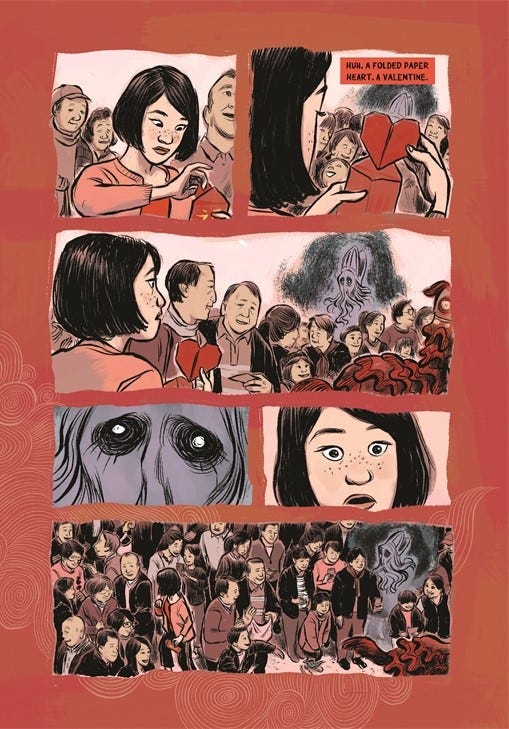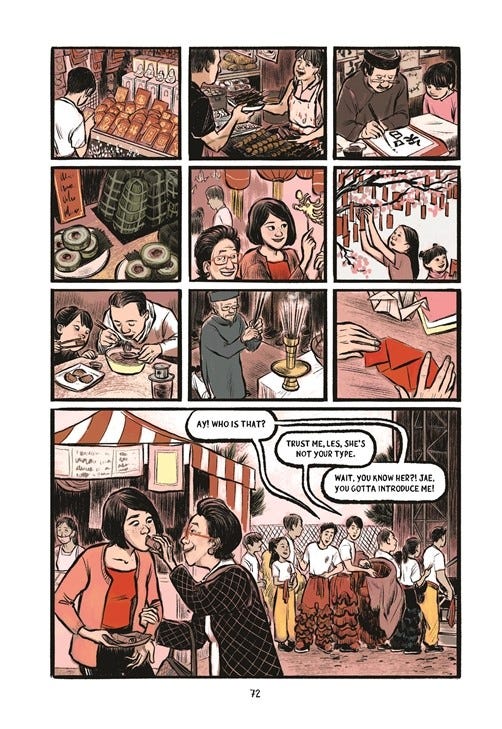Lunar New Year Love Story: Gene Luen Yang Continues to Be a Treasure
A recent YA graphic novel extends a remarkable run by a talented creator.
Lunar New Year Love Story
Written by Gene Luen Yang
Art by Leuyen Pham
Published by First Second, 2024
Buy it
Last week I reposted a review I wrote back in 2007 of Gene Luen Yang’s graphic novel American Born Chinese. In that review, I described Asian Americans as “underrepresented” and said that they weren’t as visible as some minorities in the United States. Part of that opinion was based on me being a sheltered white person, but at the time, it did seem like Asians didn’t get a lot of attention in American culture, and many of them were sick of demeaning caricatures like Long Dong in Sixteen Candles. Fortunately, that was changing, what with the increasing popularity of manga, anime, and video games, as well as more Asian actors being cast in TV shows and movies, the prominence of Asian athletes in American sports, and more representation in general.
In the years since, that representation has grown by leaps and bounds, making sure that Asian people are recognized as an essential part of American culture. They’ve been featured in sitcoms like Fresh Off the Boat and dramatic series like Beef. There have been smash-hit romantic comedies like Crazy Rich Asians, Oscar-winning movies like Everything Everywhere All at Once, raunchy comedies like Joy Ride, Marvel Cinematic Universe entries like Shang Chi, indie darlings like Past Lives, and so much more. And all of these have not just featured Asian characters, they’ve been made by Asian creators who have centered the Asian American experience.
During this time, in the world of comics, Gene Luen Yang has been one of these driving creative forces, creating comics for kids, writing superhero comics for Marvel and DC (including a memorable series in which Superman fought the KKK), and adding more books about Asian Americans and other characters to the ever-growing graphic novel sections in bookstores and libraries. He’s become something of a superstar in the field, mostly focusing on books targeted at kids and YA audiences, and he’s continued to enrich the culture by providing relatable stories with characters and situations that many people are sure to recognize.
That trend continues with his latest YA book, Lunar New Year Love Story. It’s written by Yang and illustrated by Leuyen Pham, who has also created a large number of graphic novels and children’s books. It’s another good story exploring Asian American culture, although it doesn’t go out of its way to make it seem like the characters have to fit into the culture or communities of the United States. It treats these people as belonging in the U.S. as much as anyone while letting them focus on their individual needs and desires rather than trying to make them bear the weight of an entire people.
The main character here is Valentina, who, as we learn in a prologue, loves Valentine’s Day. Each year, when February rolls around, she imagines that she’s accompanied by a cute cupid character she calls Saint V, and she makes valentines by hand to give to her classmates. But the most important valentine always goes to her dad, and it’s meant to be from Valentina’s mom, who she has been told died when she was a baby.
Valentina continues this tradition to the point where she’s getting a bit old for it, and when she’s 14, in her freshman year of high school, things turn sour. Her classmates mostly make fun of her when she passes out valentines, and one boy seems to be touched at first, but then he angrily rips up his valentine and throws it away. When she gets home from school, her dad also rejects his valentine, and he seems especially upset. Her grandma shows up unexpectedly even though she had been estranged from Valentina’s dad for several years. She takes Valentina to a Catholic church service, where she’s surprised to see a statue of the “real” St. Valentine, who looks more like a solemn, stern, imposing old man than a cute winged baby. And then Grandma drops a bomb on Valentina that makes her rethink everything she thought she knew about love.
At this point, Saint V transforms from a cute friend to the imposing, statuesque figure from church, and he turns from an encouraging source of support to a haunting reminder that Valentina may follow in the footsteps of all the family members that her grandma told her were unlucky in love. She begins to wonder if she’ll ever be able to find true love. In fact, by the time she gets to her junior year, Saint V is now requesting that she give him his heart, which he will guard so that she will never have to suffer heartbreak. He gives her one year to find true love before she’ll have to turn over her heart to him. Is she doomed to a life without love?
Well, the title of the book contains the words “love story,” so we can probably figure out that things won’t turn tragic like Valentina fears. When she accompanies her grandma to a celebration of Tết, the Vietnamese new year, she witnesses a lion dance performed by some boys from a local kung fu studio. She’s blown away by the vibrant energy of the dance, especially after a lion slips her an envelope with a paper heart inside, indicating that one of the boys has a crush on her. When she talks to the boys afterward, they invite her to come down to the studio to learn more about lion dancing, and soon enough, she’s hooked, joining the team and becoming a key performer in the troupe.
As you might expect, this leads to something of a love triangle, with two boys competing for her attention, one of them being Jae, the boy who previously ripped up her valentine. Valentina ends up dating the other boy, Les, who is a handsome ladykiller. She’s unsure about whether he’s interested in anything serious, but she stays with him in hopes that their relationship will last. But at the same time, she’s being influenced by her best friend Bernice, who doesn’t believe in true love because of her parents’ unhappy relationship and seems to have a new boyfriend every week.
And that’s how things proceed through most of the book, with Valentina getting closer with Jae as she wonders whether Les really cares about her, but feeling like time is ticking away as the deadline to find true love nears. There are some interesting twists and turns, including a race to make it to a final confession of love that’s straight out of a romantic comedy movie. It all works really well, making for a cute story that evokes some real, relatable emotions even amidst the visits from ghostly apparitions and the heightened drama affecting the characters.
While much of the success of the story comes from Yang’s characterization and sharp writing, Leuyen Pham’s art is what really sells the characters’ emotions, the richness of their community and traditions, and the extreme nature of the teenage emotions at play. Valentina’s feelings are expressed through exciting lion dances and dark, oppressive portents of doom that convey a sense of sadness and depression really well. Pham has a knack for conveying emotions through facial expressions and body language while making sure all the characters are unique. It’s gorgeous work, selling everything from everyday moments to flights of fancy. There are some highly dramatic scenes involving revelations and confrontations, and they play out in a horrifyingly relatable fashion, letting us understand what the characters are feeling based on their shocked or saddened expressions and the ways these moments linger and continue to affect them.
What’s more, Yang and Pham build out the world surrounding the main characters, situating them in a rich community full of interesting people, each with their own desires and pursuits. Les’s dad owns a chain of frozen yogurt shops, and he sponsors the kung fu studio, giving him the opportunity to pop up every so often and promote his business. Jae’s uncle is a goofball artist who welds together sculptures in his garage while lecturing the kids on the superiority of Korean lion dancing. It’s wonderful to watch these characters all bounce off each other and to see the kids absorb influences that will shape their lives.
This book is more than just the emotionally affecting love story indicated by the title; it’s a rich, beautiful experience that’s full of well-realized characters, lovely artwork, and affecting moments. While it’s definitely targeted at a young adult audience, I still got a lot out of it as a guy in my 40s who is overly cynical and generally shuns stories about teenage characters. If somebody this far out of the primary audience can enjoy it so much, I can only imagine how it’ll hit for people who have a much more immediate connection with the emotions and experiences being depicted. This book shouldn’t be missed.







